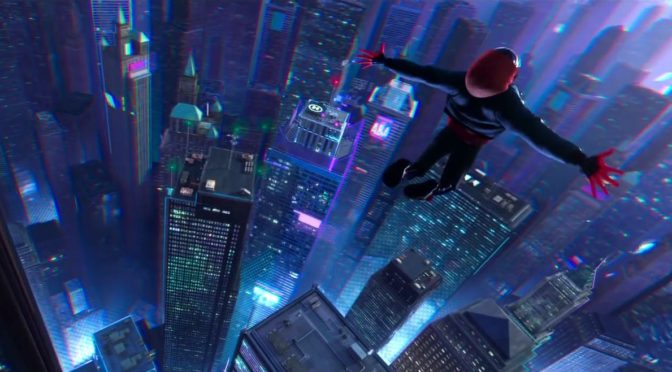The setting is New York, 2018. After teenager Miles Morales is bitten by a radioactive spider, he must race against time to stop the villainous Kingpin from opening a portal to another dimension, and causing the multiverse to collapse. Struggling with his new spider-like superpowers, Miles is in desperate need of guidance. Luckily, when the portal briefly opens, it brings help: not one, but five alternate-universe versions of Spiderman.
SPIDER-MAN: INTO THE SPIDER-VERSE is a standalone computer-animated superhero movie co-written by Phil Lord, who some will recognise as part of the two-man director/writer team behind the surprisingly wonderful THE LEGO MOVIE. As such, expectations for SPIDER-VERSE have been justifiably high amongst comic book literati and animation geeks alike. But SPIDER-VERSE surpasses all expectations. It’s an incredibly ambitious film, rolling with an insane premise to deliver a punchy high-stakes story, spectacular fight scenes and animation that will knock you down. It engages with the pop-culture mythology of the Spiderman character without ever being self-indulgent. It’s also very, very funny.
Of the countless wonderful things about SPIDER-VERSE, the animation is the most striking – well-equipped to portray the world-bending effects of the Kingpin’s portal, the universe glitches and changes in ways that far outstrip the closest live-action facsimile, DOCTOR STRANGE. The final fight scene, in particular, looks incredible. While it may be easy to complain about ‘the way cinema is going these days,’ SPIDER-VERSE is only further proof that we are living in a Golden Age of Animation. Not only overwhelmingly beautiful, the film is also consistently inventive and keen to make the most of its premise. Each ‘Spider-person’ is animated in a different style, to represent their alternate universe. Spider-Man Noir (Nicolas Cage, who recently voiced Superman in TEEN TITANS GO TO THE MOVIES) comes from a monochrome 1930s New York in which he saves dames and punches Nazis (‘a lot’). Equipped with trilby, trench-coat and Bogart-esque dialogue, he finds Rubik’s cubes baffling, since he is only animated in black-and-white. In contrast, Peter Porker, who comes from a universe where animals can talk, is a pig (‘Spider-Ham’) who looks and behaves like a Looney Tunes cartoon. The animation also plays a role in the story: once Miles begins to develop superpowers, comic-book style visuals begin to seep into the frame, with captions, sound effects and speech-bubbles appearing around the characters.
SPIDER-VERSE benefits not only from its daring visual style, but also from punchy pacing and smart dialogue. The plot is deceptively simple, allowing room for its many characters to interact, and for us to become invested. Never losing an opportunity to have fun with its premise, the screenplay is peppered with mythology gags and has a very well-developed funny bone, with many of the laughs coming from interactions between the various Spider-people, or from references to previous Spider-man films. For example, the cringeworthy dance scene from Sam Raimi’s SPIDER-MAN 3 gets a big nod. But don’t be fooled – alongside the humour, SPIDER-VERSE has a sense of real stakes. With a brutal plot beat that also appears in AVENGERS: INFINITY WAR, the writers establish the Kingpin as a genuinely dangerous villain in his first appearance. Suffice to say that, although SPIDER-VERSE is a PG, the spectre of mortality is never far from the audience’s minds. This risky opening gambit pays off, lending the later action set-pieces a weight and sense of danger lacking in many live-action Hollywood productions.
SPIDER-MAN: INTO THE SPIDER-VERSE does the impossible: it absolutely fulfills the potential of its premise. Consistently funny, often moving and with breathtaking action, it playfully explores the concept of a mythologised character, and simultaneously recasts him (or indeed her) for the modern age. Lastly, it’s the best-looking film you’ll see this year, demonstrating the true power of animation: that it is limited only by the imagination of its creators.

